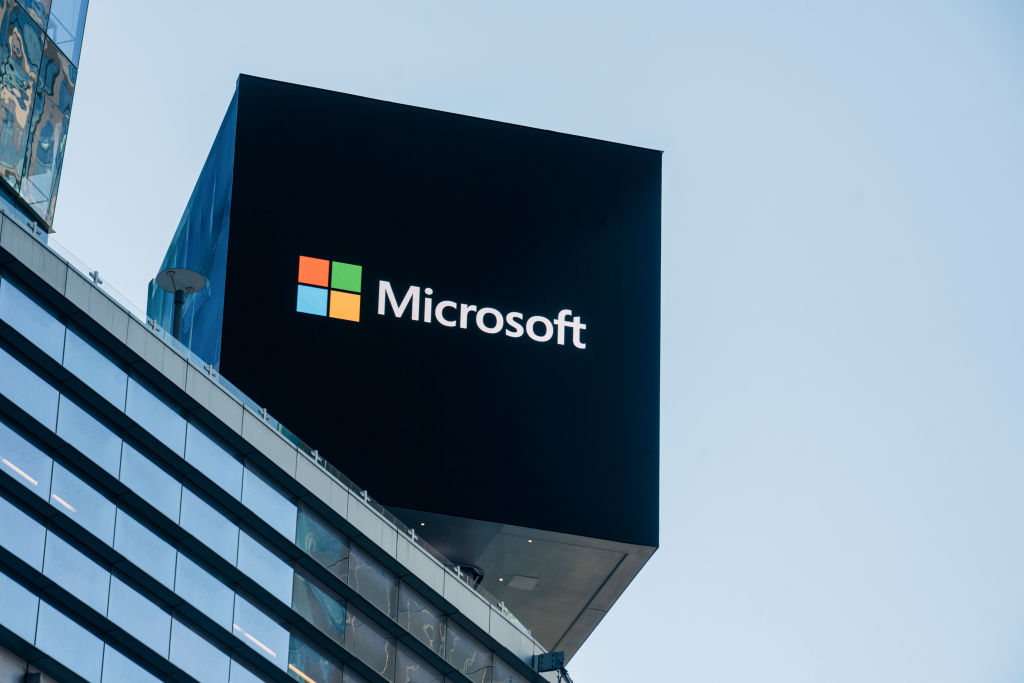Why Microsoft Stock Is Sinking After Earnings
Microsoft is the worst Dow Jones stock Thursday as the tech giant's soft outlook offsets an earnings beat. Here's what you need to know.


Microsoft (MSFT) stock is the worst Dow Jones stock Thursday, down nearly 6% at last check, after the tech giant beat top- and bottom-line expectations for its fiscal 2025 second quarter but issued a soft outlook for its third quarter.
In the three months ending December 31, Microsoft's revenue increased 12.3% year over year to $69.6 billion, led by 21% growth in Microsoft Cloud revenue to $40.9 billion. Its earnings per share (EPS) rose 10.2% from the year-ago period to $3.23.
"We delivered another quarter of double-digit top and bottom-line growth," said Microsoft Chief Financial Officer Amy Hood in a statement. "Results were driven by strong demand for our cloud and AI [artificial intelligence] offerings while we also improved our operating leverage with higher-than-expected operating income growth."
From just $107.88 $24.99 for Kiplinger Personal Finance
Become a smarter, better informed investor. Subscribe from just $107.88 $24.99, plus get up to 4 Special Issues

Sign up for Kiplinger’s Free Newsletters
Profit and prosper with the best of expert advice on investing, taxes, retirement, personal finance and more - straight to your e-mail.
Profit and prosper with the best of expert advice - straight to your e-mail.
The results topped analysts' expectations. Wall Street was anticipating revenue of $68.8 billion and earnings of $3.11 per share, according to CNBC.
However, sentiment turned negative toward Microsoft when it provided an outlook for its fiscal third quarter on its conference call. The company expects revenue in the range of $67.7 billion to $68.7 billion, which came in well below analysts' expectations for revenue of $69.8 billion.
Brian Mulberry, client portfolio Manager at Zacks Investment Management, says Wall Street could also be disappointed in the company's 31% year-over-year revenue growth in Azure, its cloud computing platform, which slightly missed analysts' estimates for 32% growth.
"This has been a key component of both revenue growth and profitability that will be critical in funding the capex projects announced around AI infrastructure," Mulberry notes. " Long term, the balance sheet looks healthy and the revenue growth is still a net positive."
Is Microsoft stock a buy, sell or hold?
Microsoft has been choppy on the price charts over the past 12 months, up roughly 9% vs the S&P 500's 23% gain. But Wall Street is keeping the faith on the blue chip stock.
According to S&P Global Market Intelligence, the average analyst target price for MSFT stock is $507.47, representing implied upside of about 20% to current levels. Additionally, the consensus recommendation is Strong Buy.
Financial services firm Wedbush maintained its Outperform rating (equivalent to a Buy) and $550 price target following the earnings release.
"Overall, there was some weak spots along with a 2% currency headwind next quarter that could put some pressure on shares this morning," says Wedbush analyst Dan Ives. "That said, we are laser-focused on the AI piece of this MSFT story and all metrics were ahead of expectations which give us added confidence in the AI Revolution bull thesis for Redmond into the rest of fiscal year 2025."
Related Content
- If You'd Put $1,000 Into Microsoft Stock 20 Years Ago, Here's What You'd Have Today
- Earnings Calendar and Analysis for This Week
- Is Meta Stock a Buy, Hold or Sell After Earnings?
Profit and prosper with the best of Kiplinger's advice on investing, taxes, retirement, personal finance and much more. Delivered daily. Enter your email in the box and click Sign Me Up.

Joey Solitro is a freelance financial journalist at Kiplinger with more than a decade of experience. A longtime equity analyst, Joey has covered a range of industries for media outlets including The Motley Fool, Seeking Alpha, Market Realist, and TipRanks. Joey holds a bachelor's degree in business administration.
-
 Changes Are Coming for This Invesco Bond Fund
Changes Are Coming for This Invesco Bond FundThe Invesco BulletShares 2026 Corporate Bond ETF's bonds will mature in 2026. Here's what investors should do.
-
 What Science Reveals About Money and a Happy Retirement
What Science Reveals About Money and a Happy RetirementWhether you’re still planning or already retired, these research-based insights point the way to your best post-work life.
-
 7 Retirement Planning Trends: What They Mean for You in 2026
7 Retirement Planning Trends: What They Mean for You in 2026From government shutdowns to market swings, the past 12 months have been nothing if not eventful. The key trends can help you improve your own financial plan.
-
 Changes Are Coming for This Invesco Bond Fund
Changes Are Coming for This Invesco Bond FundThe Invesco BulletShares 2026 Corporate Bond ETF's bonds will mature in 2026. Here's what investors should do.
-
 7 Retirement Planning Trends in 2025: What They Mean for Your Wealth in 2026
7 Retirement Planning Trends in 2025: What They Mean for Your Wealth in 2026From government shutdowns to market swings, the past 12 months have been nothing if not eventful. The key trends can help you improve your own financial plan.
-
 What Defines Wealth: Soul or Silver? Good King Wenceslas' Enduring Legacy in the Snow
What Defines Wealth: Soul or Silver? Good King Wenceslas' Enduring Legacy in the SnowThe tale of Good King Wenceslas shows that true wealth is built through generosity, relationships and the courage to act kindly no matter what.
-
 An Investing Pro's 5 Moves to Help Ensure 2025's Banner Year in the Markets Continues to Work Hard for You in 2026
An Investing Pro's 5 Moves to Help Ensure 2025's Banner Year in the Markets Continues to Work Hard for You in 2026After a strong 2025 in the stock market, be strategic by rebalancing, re-investing with a clear purpose and keeping a disciplined focus on your long-term goals.
-
 The Santa Claus Rally Officially Begins: Stock Market Today
The Santa Claus Rally Officially Begins: Stock Market TodayThe Santa Claus Rally is officially on as of Wednesday's closing bell, and initial returns are positive.
-
 Introducing Your CD's Edgier Cousin: The Market-Linked CD
Introducing Your CD's Edgier Cousin: The Market-Linked CDTraditional CDs are a safe option for savers, but they don't always beat inflation. Should you try their counterparts, market-linked CDs, for better returns?
-
 'Humbug!' Say Consumers, Despite Hot GDP: Stock Market Today
'Humbug!' Say Consumers, Despite Hot GDP: Stock Market Today"The stock market is not the economy," they say, but both things are up. Yet one survey says people are still feeling down in the middle of this complex season.
-
 The SEC Is Concerned for Older Investors and Retirement Savers. Here's What You Should Know.
The SEC Is Concerned for Older Investors and Retirement Savers. Here's What You Should Know.The SEC focusing on older investors, retirement and college savers, and private securities. Here's how those changes impact you.